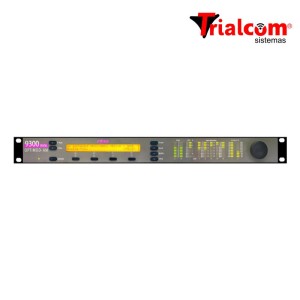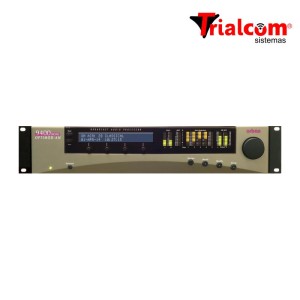Optimod-TV 6585
Optimod-TV 6585 Surround Loudness Controller
Artifact-Free Automatic Loudness Control Requires Much More Than Just “Processing for the BS.1770 Meter.”
Orban’s value-priced Optimod 6585 surround/stereo television loudness controller builds on Orban’s 30+ year experience in television audio processing to provide audibly transparent automatic loudness control and dialog intelligibility control for one surround program (up to 7.1) or four stereo (stereo) programs. The stereo processing can operate in dual-mono mode, so it can process four subchannels in stereo or eight subchannels in mono. Put in-line and operated correctly, the 6585 will ensure that loudness meets the requirements of the CALM Act and EBU R-128.
The 6585 features 3G HD-SDI and AES3id input/output, plus comprehensive handling of metadata. The 6585 is Dialnorm-aware and can re-author metadata as needed. Seamless switching between processing and pass-through modes (where both audio and metadata are passed through without further processing) allows the 6585 to pass pre-qualified material without modification—you can use the 6585’s transparent-sounding loudness control only when needed. This makes it easy to comply with the requirements of network program providers who preprocess their audio feeds to comply with Recommendations A/85 and R-128.
For each logical processing channel (surround or stereo), the 6585 has one loudness controller and two loudness meters. The short-term meter uses second-generation CBS Technology Center loudness metering technology with an integration time of 200 ms, which is slightly faster than a standard VU meter. The long-term meter, which has an integration time of several seconds, is switchable between the ITU-R BS.1770-1 and 1770-2 standards (i.e. ungated or gated). Its readings can be logged for up to a week in the 6585’s internal memory and for an essentially unlimited time via the included 6585 PC Remote Software for Windows®. This allows you to retain proof that your transmissions have complied with the CALM Act.
The 6585 controls loudness smoothly and unobtrusively without the unnatural-sounding gain pumping, noise breathing, harshness, stereo image shifts, and compromised dialog intelligibility that can result from naive designs whose only goal is to make a BS.1770 loudness meter look good. Only experienced human listeners can assess these artifacts; the BS.1770 meter cannot indicate them.
Since 1980, Orban has sold thousands of Optimod-TV processors and these have processed millions of hours of on-air programming. No other manufacturer can make this claim. Over the decades, we have constantly refined and polished our loudness control algorithms to provide audibly transparent loudness control that never annoys audiences. Instead of using BS.1770 as a simplistic internal model that determines how loudness is controlled, we use a much more sophisticated multiband psychoacoustic model to do this. This model is based on years of research at CBS Laboratories and CBS Technology Center and was further refined by us. This model allows the 6585 to control both short-term and long-term loudness. The only purpose of the 6585’s built-in BS.1770 meter is to verify that our model controls long-term loudness effectively according to the BS.1770 standard. Thousand of hours of subjective listening tests have verified that our model controls loudness without irritating audiences. The 6585 meters the processing; it doesn’t process for the meter.
Automatic loudness control is just the beginning. Because not all program material is mixed perfectly, we have designed the 6585 to re-equalize and de-ess dialog and will automatically correct the balance between dialog and other program elements as necessary.
In surround mode, the 6585 provides a simultaneous stereo downmix that is loudness-controlled, peak-controlled, and pre-emphasis aware, so it can drive an analog TV transmitter in countries that simulcast digital and analog signals. In stereo mode, the four stereo processors can be made pre-emphasis aware, allowing the 6585 to be purchased for immediate use with analog transmitters with the assurance that it will provide no-compromise processing for digital transmissions when the need arises. A second use for the stereo processors is processing up to four different languages in DTV program streams.
In addition to standard HD-SDI I/O and AES3id I/O, the 6585 optionally supports Dolby-E streams from and to the AES3id and SDI I/O via plug-in Dolby-manufactured modules. The 6585 can accept and emit Dolby-E metadata via RS485 serial (per SMPTE RDD 6-2008), Dolby-E-encoded streams (when the Dolby-E decoder option is fitted), and SDI [per SMPTE 2020-2-2008 (Method-A) and SMPTE 2020-3-2008 (Method-B)].
Dual redundant power supplies with independent AC line inputs help ensure maximum uptime.







